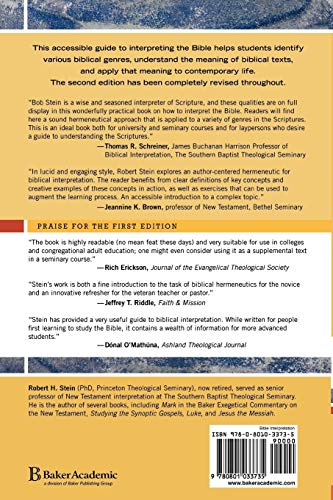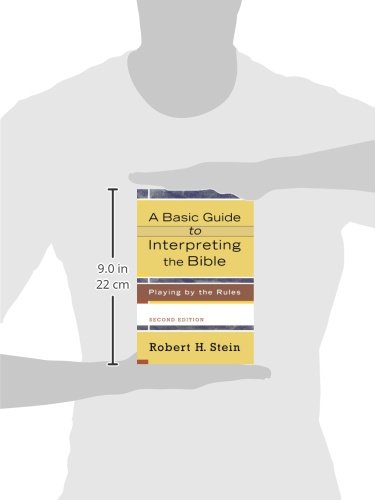



A Basic Guide to Interpreting the Bible: Playing by the Rules
A**R
Must read!!!
I'm currently using this book at a bible institute and it has been great. The first 3 chapters could be overwhelming but afterwards its an easy read.
J**N
Awesome Resource
Stein seeks to provide a clear, adequate, and correct hermeneutical framework in order to help readers understand and apply biblical texts to their own life. In chapters one through four Stein introduces and defines his hermeneutical philosophy, its terms, its literary forms, and the role of the Spirit in interpretation. In chapters five through fourteen, Stein details the characteristics of each genre, along with the principles for interpretation corresponding to each genre. He also provides a list of questions at the end of each chapter that encourages the reader to think more deeply about the how each genre influences interpretation.Critical AnalysisIn chapter one, Stein provides a clear explanation of the roles that the author, the text, and the reader have in the process of interpreting the bible. Stein interacts with differing views, answers objections to his own view, and offers logical and convincing arguments with biblical and extra biblical evidence. Chapter two includes helpful figures and charts to clarify hermeneutical terms and their relationship to one another. In chapter three, Stein explains the role of the Spirit in biblical interpretation with scriptural evidence and addresses common misconceptions. Chapter four explains how the literary form influences a text’s meaning through numerous biblical examples. In chapter five, Stein uses the example of Mark 1:2-8 to show how genre influence interpretation and focus (88). In chapter six, Stein gives two principles for understanding OT covenants: their gracious nature and already-existing covenantal relationship (103). In chapter seven, Stein shows the importance of parallelism in poetry by explaining Col. 1:15-20 (114-116). In chapter eight, Stein explains how Psalms of praise can be recognized by introductory expressions like Hallelujah, and they often include a description of what God has done (127). Chapter nine explains why proverbs should be understood as “generalizations learned from careful observation and a wise analysis of life” (133). In chapter ten, Stein gives clarity to the literary form of prophecy by pointing out the different language it employs and the different possibilities of fulfillment. In chapter eleven, Stein shows how we can understand biblical idioms by looking at their context and other biblical references. In chapter twelve, Stein refutes the allegorical method for interpreting parables, and provides one main rule for interpretation: seek the author’s intended, one basic point for telling the parable. In order to recognize exaggeration, Stein gives five main principles: the statement is impossible, it is contradictory to what other statements in the bible teach, other passages interpret it non-literally, prophecy was not literally fulfilled, and it uses universal language. In chapter fourteen, Stein describes how the meanings of words contained in correspondence are influenced by their literary context and cultural context.
B**Y
An important resource for any student of literature, but especially for those who study the Bible
Stein walks through the rule needed when interpreting a text from a different language and culture, i.e. the Bible. These rules should be obvious, like what did the original author intend to say in the text? Or, the text means what it says, not what we want it to say, but there are timeless principles that do apply to us today. The first section of the book presents the General Rules of Interpretation (Hermeneutics). This section itself is worth the price of the book. The second section talks about interpreting various genres, which Stein call "Rules for the Individual Games." That section is helpful to anyone who wants to read any genre intelligently. Finally, there are helpful picture and tables throughout the book that illustrate key points that Stein is making. I found them to be very helpful. This is a must read for any Pastor, Sunday School teacher, Seminary Student or Professor.
P**A
Best book covering this topic!
Having taken hermeneutics from Dr. Stein before this revised edition was available, I strongly encourage everyone to read this book multiple times and to listen to Stein’s lectures on biblicaltraining.org.You will discover the knowledge, warmth, and humility of a master teacher, full of wisdom, striving to develop the interpretive skills of his students.
E**A
Jugando por la regla.
I love the way this book is structured, is so easy to read and so essentially need it. You need this book if you are looking to understand your bible in a organize and theological sound manner.
D**R
Great Book
This is a great book for understanding Biblical interpretation. I used it for a Master's level Hermeneutics class and found it to be a great asset to what the Professor was teaching. It has also helped me in my daily personal studies in gaining greater insight into what God is telling us through His written word.
H**R
Get one
A good intro to the subject but Ive read others I liked better.
R**N
Easy to follow
This book was assigned in a class. I initially checked it out from the library but after viewing it I bought a copy. It is easy to follow the author's points and the author builds his points from chapter to chapter. A good read.
D**R
A Curate's Egg
The second half is better than the first. He is too dogmatic and pernickety with his definitions. However, once you get to the chapters dealing with the differing genres of writing, Stein makes some useful contributions to helping with biblical interpretation.
TrustPilot
1 个月前
5天前